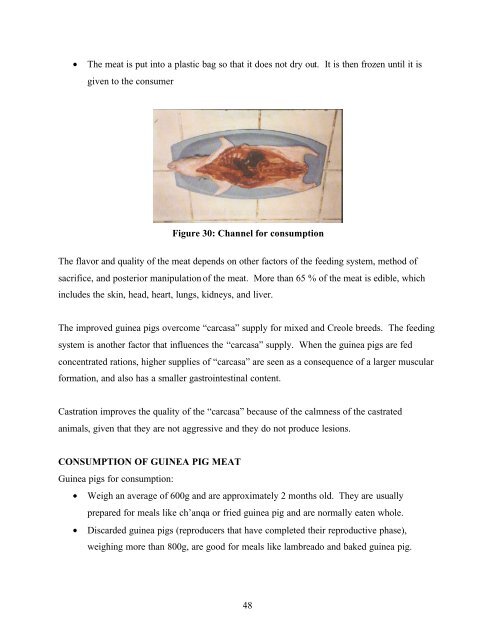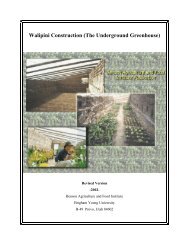GUINEA PIG MANAGEMENT MANUAL - Benson Institute
GUINEA PIG MANAGEMENT MANUAL - Benson Institute
GUINEA PIG MANAGEMENT MANUAL - Benson Institute
You also want an ePaper? Increase the reach of your titles
YUMPU automatically turns print PDFs into web optimized ePapers that Google loves.
• The meat is put into a plastic bag so that it does not dry out. It is then frozen until it is<br />
given to the consumer<br />
Figure 30: Channel for consumption<br />
The flavor and quality of the meat depends on other factors of the feeding system, method of<br />
sacrifice, and posterior manipulation of the meat. More than 65 % of the meat is edible, which<br />
includes the skin, head, heart, lungs, kidneys, and liver.<br />
The improved guinea pigs overcome “carcasa” supply for mixed and Creole breeds. The feeding<br />
system is another factor that influences the “carcasa” supply. When the guinea pigs are fed<br />
concentrated rations, higher supplies of “carcasa” are seen as a consequence of a larger muscular<br />
formation, and also has a smaller gastrointestinal content.<br />
Castration improves the quality of the “carcasa” because of the calmness of the castrated<br />
animals, given that they are not aggressive and they do not produce lesions.<br />
CONSUMPTION OF <strong>GUINEA</strong> <strong>PIG</strong> MEAT<br />
Guinea pigs for consumption:<br />
• Weigh an average of 600g and are approximately 2 months old. They are usually<br />
prepared for meals like ch’anqa or fried guinea pig and are normally eaten whole.<br />
• Discarded guinea pigs (reproducers that have completed their reproductive phase),<br />
weighing more than 800g, are good for meals like lambreado and baked guinea pig.<br />
48



